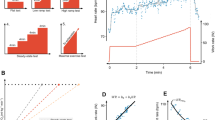Summary
After undergoing initial assessments of percentage of body fat (% fat), triglycerides (TG), total cholesterol (TC), high-density lipoprotein cholesterol (HDL-C), low-density lipoprotein cholesterol (LDL-C), and maximal oxygen consumption (VO2Max), a group of 24 paid male fire fighters (mean age, 30.1 ± 7.7 years) began a mandatory exercise program. The physiological variables mentioned above were assessed once a year for the subsequent 5 years. A repeated-measures multivariate analysis of variance followed by univariate post hoc techniques showed a minimal but statistically significant improvement in % fat (−1.43% ± 0.66%) and TG (−27.54 ± 10.44 mg/dl) over the 5-year period. Significant differences in TC, HDL-C, LDL-C, and VO2Max were noted over the years, but their magnitudes were small and no pattern was demonstrated. Each of the 5-year means for TC, LDL-C, % fat, and VO2Max were outside the desirable ranges. We concluded that mandatory exercise programs do not significantly alter the risk factor status or the aerobic fitness levels of fire fighters and that a significant number of the latter demonstrate a higher than average risk for cardiovascular disease.
Similar content being viewed by others
References
American College of Sports Medicine (1989) Resource manual for guidelines for exercise testing and prescription. Lea and Febiger, Philadelphia, pp 163–164
American Heart Association (1980) Recommendations for human blood pressure determinations by sphygmomanometers. American Heart Association
American Heart Association (1989) 1990 Heart and stroke facts. American Heart Association
Bahrke MS (1982) Voluntary and mandatory fitness programs for fire fighters. Physician Sports Med 8:127–131
Barnard RJ, Anthony DF (1980) Effect of health maintenance programs on Los Angeles city fire fighters. J Occup Med 22:667–669
Barnard RJ, Gardner GW, Diaco NV (1975) Near maximal ECG stress testing and coronary artery disease risk factor analysis in Los Angeles city fire fighters. J Occup Med 17:693–695
Brozek J, Grande F, Anderson T (1963) Densitometric analysis of body composition; revision of some quantitative assumptions. Ann NY Acad Sci 110:113–140
Cady LD, Bischoff DP, O'Connell ER (1979) Strength and fitness and subsequent back injuries in first fighters. J Occup Med 21:269–272
Davis PO, Dotson CO (1987) Physiological aspects of fire fighting. Fire Technol 23:280–291
Foster C, Jackson AS, Pollock ML (1984) Generalized equations for predicting functional capacity from treadmill performance. Am Heart J 107:1229–1234
Friedwald WT, Levy RI, Fredrickson DS (1972) Estimation of concentration of low-density lipoprotein cholesterol in plasma, without the use of the preparative ultracentrifuge. Clin Chem 18:499–502
Goldman RF, Buskirk ER (1959) Respiratory function tests: normal values of medium altitudes and the prediction of normal result. Am Rev Tuberc Pulm Dis 79:457–467
Grove TH (1979) Effect of reagent pH on determination of high density lipoprotein cholesterol by precipitation with sodium phosphotungstate-magnesium. Clin Chem 25:560–564
Laguna D (1984) Keeping fit to stay alive. Texas Fireman March: 9–11
Mealey M (1979) New fitness for police and fire fighters. Physician Sports Med 7:96–100
National Cholesterol Education Program (1989) High blood cholesterol in adults. National Institutes of Health Publication 89-2995, Bethesda, pp 6–9, 23, 74
Picher MA (1987) Fire fighter heart attacks. Fire Command 54:16–20
Puterbaugh JS, Lawyer CH (1983) Cardiovascular effects of an exercise program: a controlled study among firemen. J Occup Med 25:581–586
Rautela GS, Liedtke RJ (1978) Automated enzymic measurement of total cholesterol in serum. J Clin Chem 24
Rautela GS, Hall RG, Bekiesz CL (1974) A kinetic method for the rapid and automatic measurement of triglycerides in biological fluids. Clin Chem 20:476
Rogers CC (1984) Firing up for fitness. Physician Sports Med 12:134–142
Washburn AE, Harlow DW, Fahy RF (1985) Fire fighter fatality report, 1986. Fire Command 53:20–27
Washburg AE, Harlow DW, Fahy RF (1986) Fire fighter fatality report, 1987. Fire Command 54:20–34
Washburn AE, LeBlanc PR, Fahy RF (1987) Fire fighter fatality report, 1988. Fire Command 55:18–35
Washburn AE, LeBlanc PR, Fahy RF (1988) Fire fighter fatality report, 1989. Fire Command 56:16–39
Author information
Authors and Affiliations
Rights and permissions
About this article
Cite this article
Green, J.S., Crouse, S.F. Mandatory exercise and heart disease risk in fire fighters. Int. Arch Occup Environ Heath 63, 51–55 (1991). https://doi.org/10.1007/BF00406198
Received:
Accepted:
Issue Date:
DOI: https://doi.org/10.1007/BF00406198




